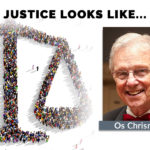EDITOR’S NOTE: “Justice looks like …” is a special series in the Voices column. Readers will have the opportunity to consider justice from numerous viewpoints. The series is based on each writer’s understanding of Scripture and relationship with Jesus Christ. Writers present their own views independent of any institution, unless otherwise noted in their bios.
You are encouraged to listen to each writer without prejudgment. Then, engage in conversation with others around you about what justice looks like to you.
Click here for more information about the series. Click here to read the full “Justice looks like…” series.
I am a community activist who is a pastor, not the other way around.
Since age 19, I have been a member of several civil rights and community-interest organizations and have participated in or led protests, boycotts, sit-ins and other nonviolent strategies in the pursuit of justice and equality for people of color, particularly African Americans.
Most recently, until the onset of the novel coronavirus, a community group I am a decades-long member of was engaged in daily downtown protests. After protesting for almost two years in the same location without any mentionable brush with local law enforcement, suddenly, without provocation or probable cause, a dozen police officers swooped in on those of us who were protesting and started writing citations for disorderly conduct, noise and any other infraction they could conjure up. This happened almost every day for a month and a half.
We had been protesting peacefully within the parameters of city ordinances and state statutes, without incident, other than the routine harassment from those who had problems with African Americans observing their First Amendment right to “redress grievances.”
Why were protesters receiving multiple citations now and had not been cited even once for the 23 months prior? Then, why did the writing of citations stop as abruptly as they started?
We discovered the timeline of the writing of citations was wed to the last month of a highly contested citywide election. But, we still had to hire attorneys and currently are bound-up in litigation.
Sign up for our weekly edition and get all our headlines in your inbox on Thursdays
I refer to this because it illustrates the opposite of what justice looks like to me.
Inequitable administration
Justice looks like equity in the administration of justice in the criminal justice system, including policing, criminal prosecutions, trials, sentencing, felony disfranchisement and incarceration.
Evidence of discriminatory abuse within the framework of the administration of justice is incontrovertible. Too often, the law enforcement apparatus acts outside the law to uphold the socio-cultural-economic status quo, denying marginalized racial and ethnic groups equal protection by the courts and police.
Researchers Marc Mauer and Nazgol Ghandnoosh argue correctly, stating, “Persistent racial disparities in the justice system have been shown to harm both individuals in the system as well as their families and communities.”
What happens when an African American mother—Jackie Craig—calls the police because a white neighbor assaults her son, and the responding white officer, without provocation, insults and assaults her and her daughters?
Why is it OK for a peaceful demonstrator to be arrested without cause and then jailed and required to post bond?
Why is it not a problem with folks on “the other side of town” when the courts and police contravene the principles of justice and equal protection of the laws that should be the crux of any criminal justice system?
Mitigating racial disparities
In their 2014 study Racial Disparities in Incarceration Increase Acceptance of Punitive Policies, Rebecca C. Hetey and Jennifer L. Eberhardt summarized, “We found that exposing [white] people to extreme racial disparities in the prison population heightened their fear of crime and increased acceptance of the very policies that lead to those disparities.”
The truth is, “racial-disparity denial” exacerbates the systemic, structural and institutional inequities that permeate every level of the justice system, from legislation to policing to sentencing.
How do we as a nation go about effectively addressing the anti-Black bias inherent in our institutions of justice?
Beyond conceptualizing relevant public policies—which frequently are ignored or dismissed—aimed at reducing justice system racial and ethnic disparities, what are we—those of us who daily are impacted negatively by the racism implicit in our criminal justice system—to do?
Beginning to honestly answer this question is a good starting place toward mitigating the unwarranted racial disparities in the criminal justice system.
Dr. Michael Bell is pastor and resident theologian at Greater St. Stephen First Baptist Church in southeast Fort Worth. He also serves as facilitator of Unity in the Community Coalition, a consortium of more than 25 community groups and organizations. The views expressed are those solely of the author.
Click here to read the full “Justice looks like…” series.















We seek to connect God’s story and God’s people around the world. To learn more about God’s story, click here.
Send comments and feedback to Eric Black, our editor. For comments to be published, please specify “letter to the editor.” Maximum length for publication is 300 words.